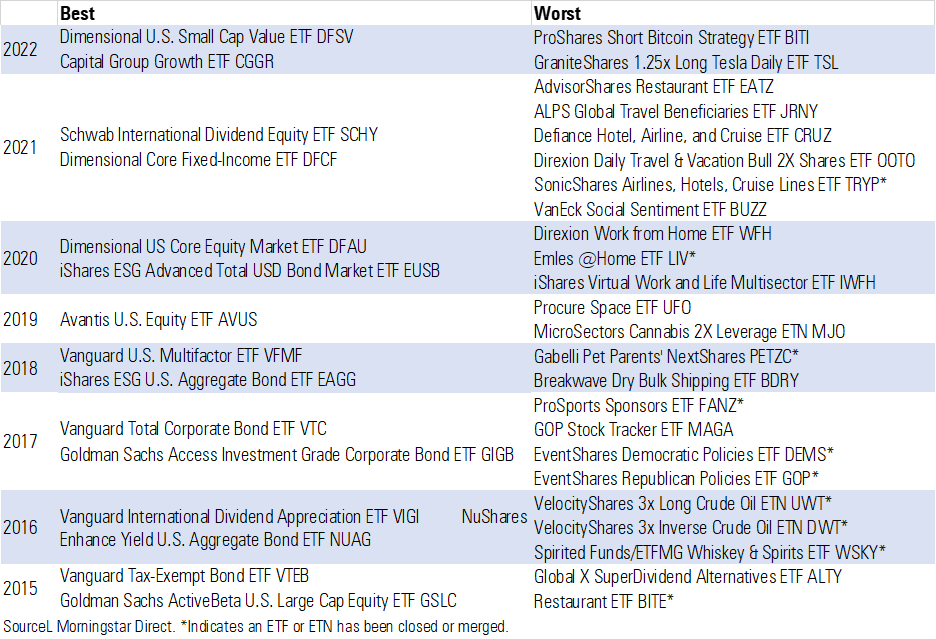The Best and Worst New ETFs of 2022
As the ETF menu continues to grow, we weigh in on this year’s best and worst new launches.

As of Dec. 14, 391 exchange-traded funds were launched in 2022, on pace to fall just short of last year’s record of 438 debuts. There are now 3,145 ETFs available to investors. There have been 4,649 ETFs brought to market since the first one debuted in 1993. This means about 32% of them have since closed. In 2022, 125 of these ETFs shuttered their doors.
The ever-expanding menu of ETFs provides options. Yet investors have parked over half of their $6.8 trillion in ETFs in the 50 largest by assets under management. The ETFs making up the top 50 offer beta exposure to commonly targeted markets, such as U.S. Morningstar Style Box categories, various bond sectors, and foreign stocks.
Every ETF in the top 50 launched prior to 2014, and they are all index funds. This demonstrates that the best options have been on the menu for a long time. It’s nearly impossible for new strategies to usurp these AUM monsters that are backed by topnotch sponsors and offer broad exposure to the market for a fee of mere basis points. New ETFs instead try to differentiate themselves by targeting new strategies or tweaking the classics.
With all this in mind, our ETF research team has taken a close look at the class of 2022 and voted on what we believe were the best and worst new ETFs launched this year.
Best New ETFs of 2022
The challenge for a new strategy is capturing investors’ attention--a task that grows each year as good ideas quickly become crowded, leaving only less-savory options for hundreds of new ETFs each year. The quickest route to success for new ETFs is to improve on a strategy that’s already successful. One way this can be achieved is by replicating top strategies while cutting costs for investors. Sometimes that comes via fees, like with newcomer Schwab Municipal Bond ETF, which entered the intermediate municipal-bond fray with a lower fee than category-leading iShares and Vanguard ETFs. Other times a new fund can cut costs for investors by offering a mutual fund strategy in an ETF wrapper, adding tax efficiency, transparency, lower operational costs, and intraday trading, to boot. However they carve their edge, investors should take note of these new ETFs.
Winners: Dimensional U.S. Small Cap Value ETF DFSV and Capital Group Growth ETF CGGR.
This year’s crop of ETFs provides something for all types of investors. And Dimensional and Capital Group’s ETFs are tied together by a common thread: both define why the actively managed ETF market is burgeoning. Dimensional and Capital Group built their top-of-the-line reputations with active mutual funds, staying away from ETFs until recent years. But the SEC’s ETF Rule in 2019 gave more leeway to active ETF managers, providing firms like Dimensional and Capital Group the tools needed to take their mutual funds to the next level using ETFs.
Actively managed funds have had a rough couple of years. The most recent Active/Passive Barometer found that active managers failed to improve on their success rates against passive funds during increased market volatility in the 12 months through June 2022. Investors took notice: Actively managed open-end mutual funds saw outflows of over $850 billion for the year through November.
However, outflows in mutual funds overshadowed a smaller, yet meaningful, trend for active managers in ETFs. Actively managed ETFs brought in over $73 billion of investors’ cash, bucking the trend for mutual funds. This represented an organic growth rate of 25% for active ETFs, meaning this segment grew over 3 times faster than ETFs overall.
The growing adoption of actively managed ETFs should come as no surprise for market observers. Major active mutual fund providers have entered the ETF fray by converting or cloning existing mutual fund strategies or adding new strategies. The improved tax efficiency of ETFs was a quick win for investors in these strategies. Accepting more holdings transparency was a major concession for active managers, but ultimately another win for investors.
This brings us to our winners of best new ETF for 2022. In both cases investors gained access to the same or similar strategies as highly successful mutual funds, but with the benefits of the ETF wrapper.
Diversified Factor Investing
Dimensional U.S. Small Cap Value ETF is as close as you can get to a Eugene Fama white paper in ETF form.¹ This isn’t by chance: Dimensional’s founders studied under Eugene Fama and Kenneth French, and Fama serves on Dimensional’s board of directors. This ETF delivers the same strategy as the highly successful mutual fund of the same name (DFSVX).
This strategy targets the smallest stocks in the U.S. market: those that land in the bottom 10% by market cap. From that universe, Dimensional’s portfolio managers focus on the cheapest third by price/book ratio. They further refine holdings by avoiding names with poor profitability and aggressive asset growth. Stocks with these characteristics have historically been associated with poor expected performance. The strategy weights stocks by market cap, which curbs turnover and the associated trading costs.
The resulting portfolio lands among the broadest and most diversified in the small-value Morningstar Category. It holds more than 800 stocks, while its 10-largest positions represent about 8% of assets. The value factor plays a prominent role in the portfolio, but Dimensional sidesteps the risk posed by value traps by avoiding stocks with poor profitability.
The mutual fund version of this strategy has been around since 1993, earning a return of 11.30% from inception through November 2022. This beat the Russell 2000 Value Index by 1.56 percentage points annualized over that time, making this a highly successful strategy that is a welcomed addition to ETF circles.
A Sensible Approach to Growth Investing
Capital Group Growth ETF CGGR brings a similar strategy to ETFs as longtime mutual fund standout, The Growth Fund of America. This mutual fund launched in 1973 and is one of the largest actively managed mutual funds in the world with over $200 billion in AUM. It’s a no-brainer win for investors to have the ability to access this strategy in ETF form.
This strategy doesn’t look like your typical large-growth fund. The managers offer broad diversification across sectors and companies, resulting in a lighter growth tilt than its average category peer. To achieve this, the managers’ expansive investment universe includes overseas companies that derive notable revenue from the U.S. It has the flexibility to allocate up to 25% of assets to foreign companies but parked about 11.7% in non-U.S. companies, as of December 2022.
It remains to be seen how closely the ETF version of this strategy mimics The Growth Fund of America. It holds a little over one third as many stocks (126), as of December 2022. However, it retains many of the same characteristics: both portfolios have significantly lower P/E and price/book than the Russell 1000 Growth.
While it doesn’t replicate The Growth Fund of America’s portfolio, Capital Group Growth ETF will look to capture its long-term success. It has beat the Russell 1000 Growth Index by 1.60% annualized since 1978. Investors should remain cautious about the ETF’s more concentrated portfolio, but it should deliver similar results to the longtime standout mutual fund.
Honorable mentions: Schwab Municipal Bond ETF SCMB, Avantis All Equity Markets ETF AVGE, Avantis US Small Cap Equity ETF AVSC.
The Worst New ETFs
Winners: ProShares Short Bitcoin Strategy ETF BITI and GraniteShares 1.25x Long Tesla Daily ETF TSL.
This category was highly competitive in 2022. Many new ETFs chased past performance or brought new strategies that provide little use for investors. With poor performance as the backdrop in 2022, we saw several greedy asset managers start to book bets on both sides of the market by offering inverse versions of their already-poor strategies. These fund providers took the form of a casino, attempting to lure in stock market gamblers.
While the inverse of a bad strategy may sound appealing, it’s not that simple. There are instances where both the long and short version of the same strategy lost money this year, leaving everyone unhappy except the fund provider that collected double the fees.
The Bitcoin Casino
ProShares lit the ETF world on fire when it launched the first bitcoin futures ETF in the U.S.: ProShares Bitcoin Strategy ETF BITO. It quickly became the fastest ETF to reach $1 billion in AUM, getting there in only two days. But bitcoin, and with it BITO, began to tank shortly after the fund launched.
While AUM dwindled due to poor performance, ProShares attempted to replace revenues by launching ProShares Short Bitcoin Strategy ETF BITI. Why make a bet on bitcoin when ProShares could play bookie and collect the vig from both sides? Each fund charges 0.95%, making this a tandem operation for ProShares.
Since BITI launched in June 2022, both BITI and BITO have managed to lose money for investors. Between June 22 and Dec. 15, 2022, BITO lost 15.93% while BITI lost 3.65%. Even gamblers should avoid this game.
You Don’t Need Options to YOLO Anymore
The first leveraged and inverse single-stock ETFs debuted in the U.S. this year, piggybacking on the gambling culture formed by r/WallStreetBets and social media influencers during the meme stock craze of early 2021. None of these single-stock ETFs offered a steeper climb for investor success than GraniteShares 1.25x Long Tesla Daily ETF TSL.
Tesla TSLA has earned a cult following thanks to its high-flying (albeit extremely volatile) stock price. GraniteShares attempted to cash in on investors’ willingness to bet on Tesla, offering 1.25 times leverage on Tesla stock at the unreasonable price of 1.15%. Investors can easily buy Tesla stock for little to no brokerage fee and with no ongoing annual expense ratio. Alternatively, they could obtain one quarter more exposure to Tesla by investing in TSL for 1.15% per year. Tesla would have to go up 4.6% in a year for TSL investors just to break even. This is not a strong proposition for investors. Luckily, few of these single-stock ETFs have caught their attention.
Honorable mentions: NightShares 500 ETF NSPY, 2x Long VIX Futures ETF UVIX, and Elevate Shares 2X Daily BETZ ETF BETX.

¹Fama, Eugene F., French, Kenneth R. (1993). “Common Risk Factors in Stock and Bond Returns.” The Journal of Finance.
The author or authors do not own shares in any securities mentioned in this article. Find out about Morningstar’s editorial policies.

/s3.amazonaws.com/arc-authors/morningstar/0fa19b38-60f6-4a0f-9e06-9869d9c57d52.jpg)
/d10o6nnig0wrdw.cloudfront.net/04-18-2024/t_34ccafe52c7c46979f1073e515ef92d4_name_file_960x540_1600_v4_.jpg)
/d10o6nnig0wrdw.cloudfront.net/04-09-2024/t_e87d9a06e6904d6f97765a0784117913_name_file_960x540_1600_v4_.jpg)
/cloudfront-us-east-1.images.arcpublishing.com/morningstar/T2LGZCEHBZBJJPPKHO7Y4EEKSM.png)
:quality(80)/s3.amazonaws.com/arc-authors/morningstar/0fa19b38-60f6-4a0f-9e06-9869d9c57d52.jpg)